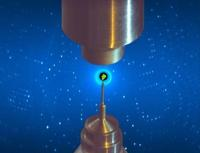Speaker
Description
An important question in the study of chromatin packing is to identify the functional significance of its structure and dynamics. The integral properties of chromatin packing as a polymer chain are extremely important for understanding the mechanisms of interaction between distant chromatin regions, the formation of loops, and, ultimately, the formation and dynamics of topologically associated chromatin domains - genome regions associated in space and having similar characteristics of transcriptional activity. The self-organization and evolution of such domains occurs under the influence of a complex of biochemical (post-translational modification of histone proteins, nucleosome dynamics, interaction of chromatin with specific nuclear proteins), and chemical (charge interactions, macromolecular crowding) factors.
Organization of genetic material in eukaryotes exhibit two-phase fractal property of chromatin during interphase, variability in its structure parameters in a number of cell types, and strong effect of macromolecular crowding on both large-scale hierarchy and small-scale nucleosome arrangements, thus providing the experimental basis for the studies chromatin organization throughout its structural hierarchy. Under certain conditions, the chromatin structure as observed by SANS can be influenced by non-nuclear proteins and protein complexes. These changes may manifest an important element in epigenetic regulation mechanisms.

